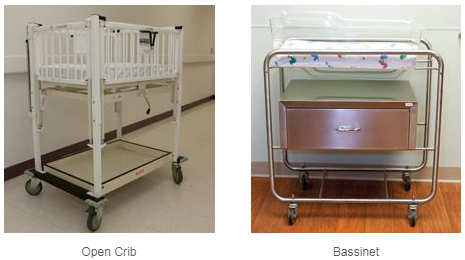Medical Equipment in the NICU
Beds
Your baby will be admitted to a radiant warmer or giraffe bed, then changed into an isolette or open crib depending on age and medical condition.


Monitors
Three sticky leads are placed on your baby’s skin to monitor heart rate and breathing. A saturation probe is placed on your baby’s hand or foot to read the oxygen level. A temperature probe may be placed on the skin, under the baby’s arm to measue the body temperature. A blood pressure cuff will be placed on your baby’s leg or arm to measure blood pressure.

-
Oxygen Saturation (blue line and number) is a measurement of how much oxygen the blood cells are carrying and is described as a percentage of 100%, normal = 80 to 93 for pre-term infants, 85 to 100 for term infants
-
Heart rate (green line and number) varies depending on infant
-
Temperature (orange number) normal is 36.2 to 37.6 Celsius or 97.2 to 99.7 Fahrenheit)
-
Respirations (white line and number) are your baby’s breaths, normal rate is 40 to 60
-
Blood pressure (purple number) varies depending on infant
- Blood pressure cuff (left leg) reads the baby’s blood pressure
- Leads (purple hearts) read the baby’s heart rate and respirations
- Saturation probe (right foot) reads the oxygen level the baby is receiving
Respiratory Equipment
- Ventilator is a machine that provides breathing support while the baby is unable to breathe on his or her own

- ET Tube is a tube that is placed in the windpipe (trachea) and goes to the lungs to help the ventilator provide breathing support for the baby

- CPAP is a machine that helps the baby breathe. CPAP prongs/mask will be placed in/on the baby’s nose. The prongs/mask allow the CPAP machine to provide breathing support to the baby.

- Nasal Cannula are small tubes that go just inside your baby's nose to give oxygen for breathing support.
- Humidified Air for the nasal cannual helps keep your baby's nose from being dried out.

- The bag and mask set-up is at every bedside. This emergency equipment is used only temporarily until the ventilator or CPAP machine is brought to your baby.

- A suction set-up is at every bedside. Suction is used to clear collected secretions/materials from airways to allow babies to breathe easier. Suction is also used to pull contents from the stomach or the lungs. Babies with certain conditions or breathing equipment may require routine suctioning of their airway with their care. Suction is readily available to use in emergencies or with procedures your baby may have done at the bedside.

IV Therapy
- Medfusion and IV pump are machines to provide intravenous nutrition, IV fluids and/or medications.

- PIV or PICC are catheters that deliver medications and IV fluid from the medfusion and IV pump to the baby.

Phototherapy
- Some babies have an elevated bilirubin level which is referred to as “jaundice”. Jaundice is a yellow-tinge in the baby’s skin or eyes. The bili-light helps to reduce the bilirubin level in the baby’s body and will prevent side effects associated with severe jaundice. The baby will have an eye mask to protect his or her eyes from the bright lights of the bili-light.

Miscellaneous Equipment

